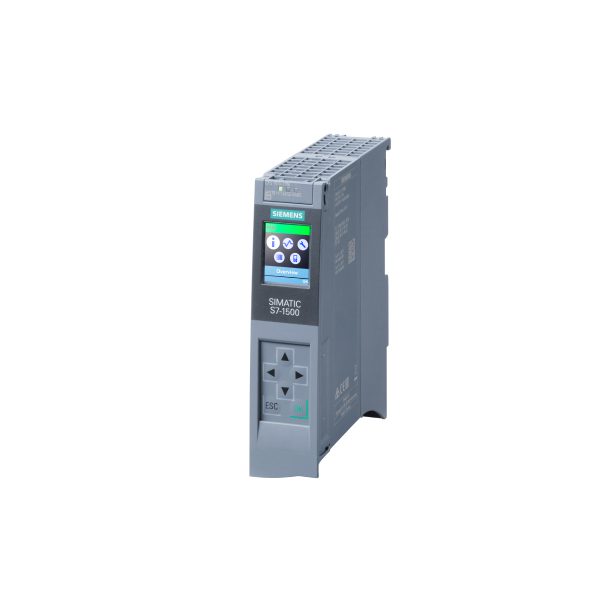The Siemens S7 1500 is a name that may sound like something from the distant future, but in reality it is a revolutionary step in industrial automation. For those who are not specialists in this field, this may sound like black magic. But let me explain it in simple terms, using analogies to everyday things.
What exactly is the Siemens S7 1500?
Siemens S7 1500 is a family of PLCs (Programmable Logic Controllers), devices used in industry to automate production processes. It is the kind of brain of the factory that controls all the machines and equipment, ensuring that they work properly.
How does it work?
Imagine that the Siemens S7 1500 is a factory motion controller, similar to a human brain. Just as the brain receives signals from different parts of the body and makes decisions, the S7 1500 receives signals from sensors and other devices, analyses them and takes appropriate action, such as starting machines when necessary.
Why is this important?
Automating production processes using the Siemens S7 1500 brings many benefits. Firstly, it improves productivity because machines can operate faster and more accurately than humans. Second, it improves quality because it eliminates human error. Thirdly, it reduces costs because it requires less human involvement.
What are the benefits for the industry?
The Siemens S7 1500 can be used in a variety of industries, from automotive to food production. This enables factories to be more efficient, flexible and competitive in the market.
How do you get on with service learning?
For those who want to learn how to use the Siemens S7 1500, there are various options. You can attend specialised courses, use online training materials or get expert help.
What are the latest trends in this area?
Industrial automation is constantly evolving, and with it the Siemens S7 1500. The latest trends include integration with the Internet of Things (IoT), artificial intelligence (AI) and data analysis. This is all aimed at making production processes even more efficient and optimised.
Is this difficult for a layman to understand?
Although the Siemens S7 1500 may appear complicated at first glance, it is in fact a tool that can be understood even by those without technical expertise. All it takes is a little time and willingness to start understanding it and using it in practice.
What are the future prospects for this technology?
The future of industrial automation seems very promising, and the Siemens S7 1500 plays a key role in it. Over time, even more integration with other technologies can be expected, which will bring further benefits to industry.
What else you should know about the S7-1500 controller
Revolutionary SIMATIC S7-1500 PLC: Increasing productivity and technological efficiency
The SIMATIC S7-1500 PLC sets new standards for increasing productivity and process efficiency. Extremely beneficial for both small batch production and complex plants with high requirements, the SIMATIC S7-1500 runs on the Totally Integrated Automation (TIA Portal) environment.
Modular Structure of SIMATIC S7-1500
The SIMATIC S7-1500 features a modular design with variable functionality, consisting of the following components:
- Central Processing Unit (CPU): It is responsible for handling the application created by the user.
- Power Unit(s): They provide the necessary power supply.
- Signal Input/Output Modules: They are used for signal processing.
- Additional Technology and Communication Modules: Additional if required.
- Safety features: Integrated into Safety modules.
SIMATIC S7-1500 benefits
- Intuitive Display: Facilitates commissioning and diagnostics.
- Shorter Downtimes: With text-based diagnostic information.
- Adaptability of the Network: Customisable network settings.
- Assembly in the Workstream: Without the need to interrupt operations.
- Password protection: Possibility to assign a password via the TIA Portal.
- Long Life: Up to 50,000 man hours.
Standard equipment SIMATIC S7-1500
- PROFINET with PN IRT (V2.2): Provides specific response times.
- Additional Ethernet interface: Optimal integration in the device network.
- Web Server: Allows easy display of service and diagnostic information.
Innovative Memory Management
- Sufficient Memory: Regardless of the industry.
- Flexible Memory Card Concept: For various projects.
- Large Capacity: Up to 32 GB of on-card memory.
- Optimised Data Modules: They allow the storage of arbitrary values.
Optimised diagnostic concept
- Efficient Error Analysis: With a unified display concept.
- Consistently Integrated Diagnostics: Without the need for additional labour resources.
- Lossless Recording of Error Messages: Even in the event of a CPU halt.
Innovations in STEP 7 programming languages
- Full Symbolic Programming: Providing greater transparency.
- Enhanced Compiler Performance: For shorter cycle times.
- Support for All 64-bit Data Types: All IEC languages.
- Simplifying Complex Mathematical Operations: Thanks to the Calculate box function in LAD.
Integrated Security
- Optimised Protection against Unauthorised Access: Via HMI.
- Investment Security: By protecting components and programmes.
- High Availability of Equipment: By protecting the integrity of the data.
Compatibility and Plug&Play
- Investment Security and Know-how: Reusable programmes.
- Instant Equipment Identification: Without having an up-to-date project.
- Service Works Without Project: With the ability to read from the CPU.
Integrated Technology Functions
- Integration of Standard Traffic Control Functions: With flexible connection to the drives.
- Standardised PLCopen Components: Guaranteeing rapid project implementation.
- TRACE: Cyclical storage of variables to optimise programmes.
- Writing in Separate CPU Memory Spaces: For easy fault localisation.
- Integrated PID Controller: For simple closed-loop tasks.
Datalog (data logging) and Recipes
- Easy Access to Data: Via Office tools and web server.
- Easy Access to Device Configuration: Via web browser or SD card reader.
Selecting the SIMATIC S7 1500 PLC: Key Factors and Applications
When designing industrial automation systems, choosing the right PLC plays a key role. Among the many options available on the market, the Siemens SIMATIC S7 1500 PLC stands out as a high-performance and reliable device. It is a dedicated solution for medium and advanced applications where flexibility, communication and advanced technology features are key.
Which model of S7-1500 unit to choose for the application ?
The SIMATIC S7 1500 PLC comprises a range of components including PLCs, binary and analogue input and output modules, as well as communication, technology and power supply modules and accessories. The extensive range of this system allows the configuration to be tailored to meet a wide variety of application needs.
Choosing the right PLC
When selecting a SIMATIC S7 1500 PLC, there are a number of factors to consider that are crucial to the efficiency of the system.
Size of Application and Resources Required
The size of the application and the amount of resources required are key factors in choosing the right controller. For small and medium-sized applications, standard models may be sufficient, while higher-performance units are recommended for more advanced applications.
Configuration of Space and Costs
For applications where limited space and cost are important, compact models are the perfect solution. They provide high functionality with minimal space and competitive costs.
Safety and Reliability
For applications where the reliability of system operation and process safety are crucial, fail-safe options are worth considering. These allow stable operation to be maintained even in the event of a failure, minimising the risk of downtime and loss.
Main CPU Units SIMATIC S7 1500
The following table provides a basic overview of the main SIMATIC S7 1500 CPUs, taking into account the different categories and their respective applications:
Standard CPUs
| Type of application | CPU model | Application | Interfaces |
|---|---|---|---|
| Small and medium-sized | CPU 1511-1 PN | Integrated I/O interface, Profinet | |
| Medium | CPU 1513-1 PN | Integrated I/O interface, Profinet | |
| Intermediate and advanced | CPU 1515-2 PN | Integrated I/O interface, Profinet, Ethernet | |
| Demanding | CPU 1516-3 PN/DP | Integrated I/O interface, Profinet, Ethernet | |
| Demanding | CPU 1517-3 PN/DP | Profinet, Ethernet, Profibus | |
| High performance | CPU 1518-4 PN/DP | Profinet, Ethernet, Profibus |
Compact CPUs
| Type of application | CPU model | Application | Interfaces |
|---|---|---|---|
| Small and medium-sized | CPU 1511C-1 PN | Integrated I/O interface, Profinet | |
| Medium | CPU 1512C-1 PN | Integrated I/O interface, Profinet |
Fail-Safe CPUs
| Type of application | CPU model | Application | Interfaces |
|---|---|---|---|
| Standard | CPU 1511F-1 PN | Profinet/Ethernet | |
| Medium | CPU 1513F-1 PN | Profinet/Ethernet | |
| Medium and large | CPU 1515F-2 PN | Profinet/Ethernet | |
| Demanding | CPU 1516F-3 PN/DP | Profinet, Ethernet, Profibus | |
| High performance | CPU 1517F-3 PN/DP | Profinet, Ethernet, Profibus |
Enhanced Processing Efficiency
Compared to previous generations, the SIMATIC S7 1500 PLC offers significant performance improvements. Thanks to a faster backplane bus, a standard Profinet interface and faster response times, this automation system provides not only greater speed, but also nanosecond-level precision.
Summary
Choosing the right SIMATIC S7 1500 PLC is crucial for the efficient automation of industrial processes. Depending on your application needs and performance and reliability requirements, you can select the right CPU for optimal system operation. With its wide range of configuration options, the SIMATIC S7 1500 PLC provides a versatile and reliable solution for a variety of industries and applications
industrial applications.
FAQs (Frequently Asked Questions)
- What exactly is the Siemens S7 1500?
Siemens S7 1500 is a family of PLCs used in industry to automate production processes. - What are the main benefits of using the Siemens S7 1500?
The main benefits are increased productivity, improved quality and reduced production costs. - Is the Siemens S7 1500 difficult for beginners to learn?
Despite its apparent complexity, the Siemens S7 1500 can be understood even by people without technical expertise. - How can you learn to use the Siemens S7 1500?



